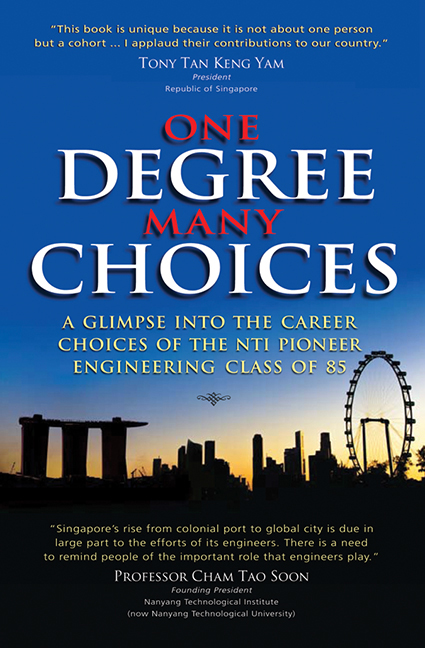 One Degree, Many Choices
One Degree, Many Choices from PART II - ENGINEERING PURSUITS
Published online by Cambridge University Press: 21 October 2015
“If we did not use explosives, we might not finish the project on time.”
— Tan Kian Thong, CSE PioneerTHE SWEAT AND TOIL of Tan Kian Thong and Chua Chiow Chye have enabled Singaporeans to get to their workplaces in a speedy manner for more than two decades. These CSE pioneers helped build an indispensable part of our lives –– the Mass Rapid Transit (MRT) system. In 2009, the MRT network has an average daily ridership of two million. That is two in five residents.
The NTI pioneers’ engineering expertise was vital in creating the backbone of Singapore's public transport infrastructure. The MRT network is a source of national pride. It is the second-oldest metro system in Southeast Asia, after Manila's Light Rail Transit System. In 1985, the government rolled out the first MRT project known as the ‘Compass Line’ or North-South-East-West line.
“We constructed the sections linking the MRT stations at Chinese Garden, Lakeside and Boon Lay,” said Kian Thong. He and Chua Chiow Chye were site engineers with Mass Rapid Transit Corporation (MRTC), which later became SMRT Corporation.
The MRT system was the brainchild of the far-sighted Singapore government, who in 1967 foresaw the need for a more reliable mode of public transport as the population increased. They decided to have the network operational by 1992. The rationale was simple. An all-bus system was not viable due to limited space in a land-scarce country. The initial five-billion dollar construction of the MRT network was then Singapore's largest public works project. Construction began on 22 October 1983 at Shan Road and the network was built in stages. The North-South Line was built first as it passed through the Central Area that had a high demand for public transport. On 7 November 1987, the initial section between Yio Chu Kang Station and Toa Payoh Station began operations. Soon after, 15 more stations opened and then Prime Minister Lee Kuan Yew officially launched the MRT system on 12 March 1988. The opening of Boon Lay Station on the East West Line on 6 July 1990 marked the completion of the system two years ahead of schedule.
The MRT project was one of two bright spots –– the other was the HDB projects –– in the gloomy construction industry during the recession of 1985.
To save this book to your Kindle, first ensure [email protected] is added to your Approved Personal Document E-mail List under your Personal Document Settings on the Manage Your Content and Devices page of your Amazon account. Then enter the ‘name’ part of your Kindle email address below. Find out more about saving to your Kindle.
Note you can select to save to either the @free.kindle.com or @kindle.com variations. ‘@free.kindle.com’ emails are free but can only be saved to your device when it is connected to wi-fi. ‘@kindle.com’ emails can be delivered even when you are not connected to wi-fi, but note that service fees apply.
Find out more about the Kindle Personal Document Service.
To save content items to your account, please confirm that you agree to abide by our usage policies. If this is the first time you use this feature, you will be asked to authorise Cambridge Core to connect with your account. Find out more about saving content to Dropbox.
To save content items to your account, please confirm that you agree to abide by our usage policies. If this is the first time you use this feature, you will be asked to authorise Cambridge Core to connect with your account. Find out more about saving content to Google Drive.